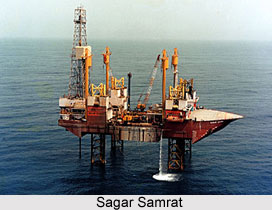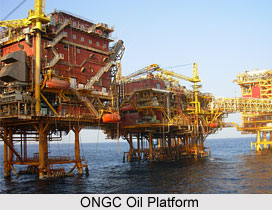 India has a very large proportion of tertiary rocks and alluvial deposits particularly in the extra-peninsular India. These sedimentary rocks, which were once under the shallow seas, hold the possibility of harbouring oil and gas deposits. Such potential oil bearing area in India is estimated to be over a million square kilometres, a third of the total area. It covers the Northern Plains in the Ganga-Brahmaputra Valley, the coastal strips together with their offshore continental shelf, the plains of Gujarat, the Thar Desert and the area around Andaman and Nicober Islands.
India has a very large proportion of tertiary rocks and alluvial deposits particularly in the extra-peninsular India. These sedimentary rocks, which were once under the shallow seas, hold the possibility of harbouring oil and gas deposits. Such potential oil bearing area in India is estimated to be over a million square kilometres, a third of the total area. It covers the Northern Plains in the Ganga-Brahmaputra Valley, the coastal strips together with their offshore continental shelf, the plains of Gujarat, the Thar Desert and the area around Andaman and Nicober Islands.
Till Independence Assam was the only state where mineral oil was drilled and refined in the refinery at Digboi. Although small in size this is the only oilfield in the world that has lasted for 100 years continuously. After Independence Gujarat Plains and the Cambay off-shore area showed evidence of hydro-carbon deposits.But the major reserves were unexpectedly found off the Mumbai coast, 115 km from the shore. So far this has been the richest oilfield of India. This oilfield is known as "Bombay High". Sagar Samrat, bought from Japan, was the first mobile offshore drilling platform. The deposits of oil were located deep under the seabed. The depth of the seawater was high enough to call for high technology. But India took up the challenge and developed the oilfield in almost a record time. Now India manufactures oil drills and mobile platforms for drilling in deep coastal waters. The latest oil deposit discoveries have also come from offshore areas off the deltaic coasts of Godavari, Krishna, Kaveri and Mahanadi. New reserves have been located in Assam.
 The gas reserves are generally found in association with oilfields. As such gas reserves are found in almost in all the offshore oilfields of Gujarat, Maharashtra, Tamil Nadu, Andhra Pradesh and Orissa. But exclusive natural gas reserves have been located in Tripura, Rajasthan.
The gas reserves are generally found in association with oilfields. As such gas reserves are found in almost in all the offshore oilfields of Gujarat, Maharashtra, Tamil Nadu, Andhra Pradesh and Orissa. But exclusive natural gas reserves have been located in Tripura, Rajasthan.
Oil Refineries in India
There are in all 14 refineries functioning in India. Their locations are based on three different considerations. Half of them are shore based as they can be easily fed by imported crude oil. Two of them are in Trombay (Mumbai), and one each at Mangalore, Kochi, Chennai, Visakhapatnam and Haldia near Calcutta. There are four inland refineries close to the oilfields. There are three plants in Assam-Digboi Guwahati and Bongaigaon. The fourth plant is in Gujarat at Koyali, which is fed by inland oilfields. The remaining three plants are near the market. They are located at Barauni in Bihar, Mathura in U.P. and Panipat in Haryana. Their total the capacity is 61 million tonnes. It is expected that in three to four years time, the capacity will increase to the 112 million tonnes. It may ensure self-sufficiency in meeting our growing needs.



















